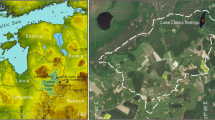Abstract
The C:N ratios of lake sediments may reflect proportions of terrestrial and algal carbon contributing to accumulation of sediment. This possibility was tested in Lake Pleasant, Massachussetts, USA which underwent watershed deforestation in about 1780 A.D. The C:N profile of a 70-cm sediment core clearly reflected deforestation through a rise in C:N ratio caused by an increase in watershed contributions to sedimentary carbon. Spatial variability of C:N in modern surficial sediments is small compared to the change caused by deforestation.
Similar content being viewed by others
References
Binford, M. W., M. Brenner, T. J. Whitmore, A. Higuera-Gundy, E. S. Deevey, Jr. & B. Leyden, 1987. Ecosystems, Paleoecology, and Human Disturbance in Subtropical and Tropical America. Quat. Sci. Rev. 6: 115–128.
Brenner, M. & M. Binford, 1988. A sedimentary record of human disturbance from Lake Miragoane, Haiti. J. Paleolim. 1: 85–97.
Goosens, H., 1989. Lipids and their mode of occurrence in bacteria and sediments – II. Lipids in the sediment of a stratified, freshwater lake. Org. Geochem. 14(1): 27–41.
Guilizzoni, P., A. Marchetto, A. Lami, G., Cameron, P. Appleby, N. L. Schnell, Ø. A. Schnell, C. A. Belis, A. Giorgis & L. Guzzi, 1996. The environmental history of a mountain lake (Lago Paione Superiore,Central Alps, Italy) for the last c. 100 years: a multidisciplinary, paleolimnological study. J. Paleolim. 15: 245–264.
Hedin, L. O., M. S. Mayer & G. E. Likens, 1988. The effect of deforestation on organic debris dams. Verhandlungen der Internationale Vereinigung für Theoretische und Angewandte Limnologie 23: 1135–1141.
Hornbeck, J. W., C. W. Martin, R. S. Pierce, F. H. Bormann & G. E. Likens, 1986. Clearcutting Northern Hardwoods Effects on Hydrologic and Nutrient Ion Budgets. Forest Sci. 32(3): 667–686.
Kanasassanen P. H. & T. Jaakkola, 1985. Assessment of pollution historyfrom recent sediments in Lake Vanajavesi, southern Finland. I. Selectionof representative profiles, their dating and chemostratigraphy. Ann. Zool. Fennici 22: 13–55.
Meyers, P. A., M. J. Leenheer, B. J. Eadie. & S. J. Maule, 1984. Organicgeochemistry of suspended and settling particulate matter in Lake Michigan. Geochimica et Cosmochimica Acta 48: 443–452.
Meyers, P. A., 1994. Preservation of elemental and isotopic source identification of sedimentary organic matter. Chem. Geol. 114: 289–302.
Thornton, S. F. & J. McManus. 1994. Application of Organic Carbon and Nitrogen Stable Isotope and C/N Ratios as Source Indicators of Organic Matter Provenance in Estuarine Systems: Evidence from the Tay Estuary, Scotland. Estuarine, Coastal and Shelf Science 38: 219–233.
Author information
Authors and Affiliations
Rights and permissions
About this article
Cite this article
Kaushal, S., Binford, M.W. Relationship between C:N ratios of lake sediments, organic matter sources, and historical deforestation in Lake Pleasant, Massachusetts, USA. Journal of Paleolimnology 22, 439–442 (1999). https://doi.org/10.1023/A:1008027028029
Issue Date:
DOI: https://doi.org/10.1023/A:1008027028029




